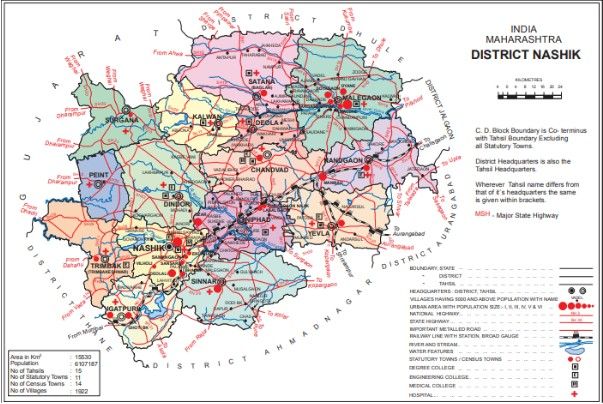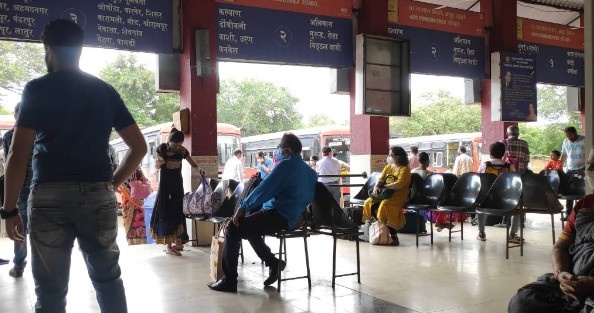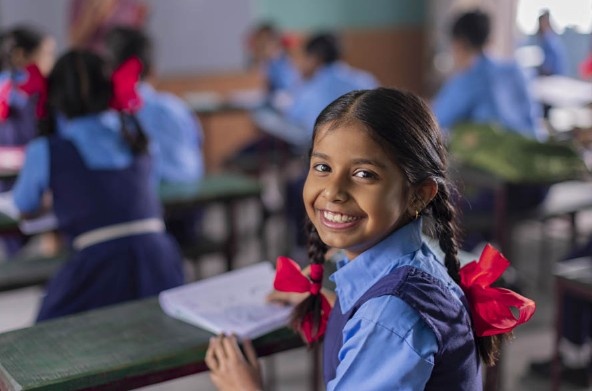The population of Nashik is estimated to reach around 23.51 lakhs by 2025, growing at an annual rate of 2.48%. This population is spread between urban and rural areas, with about 10 lakh people in cities and approximately 13.5 lakh in villages across the district.
Compared to India’s larger metro cities, Nashik’s growth is balanced and steady, reflecting its unique mix of urban and rural communities in Maharashtra. While it represents a small part of India’s total population of over 1.4 billion, Nashik remains an important hub for culture, economy, and development.
In this article, we will provide a detailed look at Nashik’s population numbers, trends, and demographics, along with the latest news, civic updates, and developments in 2025, giving you a complete overview of the city today.
Nashik District India Population 2025
As of 2025, the Nashik District’s population is estimated at 66.2 lakh (6.62 million). The district has maintained a steady growth rate of about 1.5% per year since 2011, reflecting a steady and sustainable demographic expansion.

Nashik comprises about 0.5% of India’s total population, with a growth rate slower than the national average.
Nashik Population Breakdown by Area
Unlike many urban centers experiencing rapid, uncontrolled expansion, Nashik demonstrates a measured and sustainable population increase.
- Nashik City (Urban): 25 lakh
- Nashik Rural Areas: 41.2 lakh
- Most Populous Taluka: Nashik, with approximately 18 lakh residents
- Least Populous Taluka: Peint, with around 1.3 lakh residents
Nashik Population Breakdown by Age (2025)
About 39% of Nashik’s population is under 25 years old, making it a young city with a strong workforce. Here is an estimated age-wise distribution in Nashik:
| Age Group In Nashik | Percentage | Population Estimate (In Lakhs) |
|---|---|---|
| 0-14 years | 29% | ~1,801,169 |
| 15-24 years | 10% | ~1,105,738 |
| 25-54 years | 24% | ~2,512,820 |
| 55-64 years | 23% | ~415,415 |
| 65- 79 years | 12% | ~274,910 |
| 80+ years | 2% | ~4.7 |
While specific age-wise data from the 2011 Census is not detailed in the available sources, we can refer to the general age distribution patterns observed in India during that period. Typically, India’s age distribution was the following:
- 0-14 years: 29.5%
- 15-24 years: 18.1%
- 25-54 years: 41.1%
- 55-64 years: 6.8%
- 65 years and over: 4.5%
Nashik India Population Over The Last 10 Years
Nashik’s population grew by over 674,450 people in the last 10 years. The growth rate has slightly decreased over time, from 3.09% in 2013-2018 to 2.48% in 2025.

Let us take a look at the exact population reported in the Urban areas of Nashik over the last 10 years:
| Year | Population | Growth Rate (%) | Annual Increase |
|---|---|---|---|
| 2025 | 2,351,140 | 2.48% | 56,840 |
| 2024 | 2,294,300 | 2.54% | 56,930 |
| 2023 | 2,237,370 | 2.62% | 57,100 |
| 2022 | 2,180,270 | 2.70% | 57,250 |
| 2021 | 2,123,020 | 2.77% | 57,290 |
| 2020 | 2,065,730 | 2.84% | 57,130 |
| 2019 | 2,008,600 | 2.90% | 56,600 |
| 2018 | 1,952,000 | 3.09% | 58,460 |
| 2017 | 1,893,540 | 3.09% | 56,710 |
| 2016 | 1,836,830 | 3.09% | 55,010 |
| 2015 | 1,781,820 | 3.09% | 53,370 |
Based on the table above, an interesting observation is that the annual population increase peaked in 2018 (58,460 people) and has gradually declined in Nashik.
Nashik Taluka & Village Population
Nashik District comprises 15 talukas, with a diverse population distribution:
- Nashik Taluka: 18 lakh
- Malegaon Taluka: 9.5 lakh
- Sinnar Taluka: 6.2 lakh
- Peint Taluka: 1.3 lakh
This total rural population is equal to 41.2 lakh.
Nashik Population By Religion
Now let us look at the religious composition of the Nashik district:
- Hindus: 85.8%
- Muslims: 11.3%
- Buddhists: 1.6%
- Jains: 0.6%
- Christians: 0.4%
- Sikhs & Others: 0.3%
Child Population in Nashik District (As per Census 2011)
According to the 2011 Census, Nashik district had a total of 827,935 children in the 0–6 year age group. Among them, 438,050 were male and 389,885 were female. This segment made up a significant portion of the district’s younger demographic at the time.
Working Population in Nashik District
Out of the total population of Nashik district, 2,763,328 individuals were classified as part of the working population. Among them:
- 91.3% were engaged in main work (employment lasting more than six months).
- 8.7% were involved in marginal work (employment or livelihood activities for less than six months).
Here’s a breakdown of the main workforce:
| Category | Total | Male | Female |
|---|---|---|---|
| Main Workers | 2,523,023 | 1,639,881 | 883,142 |
| Cultivators | 900,810 | 527,133 | 373,677 |
| Agricultural Laborers | 644,052 | 317,542 | 326,510 |
| Household Industries | 45,904 | 27,451 | 18,453 |
| Other Workers | 932,257 | 767,755 | 164,502 |
| Marginal Workers | 240,305 | 106,405 | 133,900 |
| Non-Working Population | 3,343,859 | 1,410,900 | 1,932,959 |
This data reflects the strong role of agriculture-based livelihoods in the region, especially with cultivators and agricultural laborers making up a substantial share of the workforce.
Additionally, female participation in marginal work and non-working categories highlights areas where further employment opportunities could be developed.
Nashik Population Sex Ratio
Nashik’s sex ratio is lower than the national average (940 females per 1,000 males). However, rural areas in Nashik show a higher female population compared to urban centers due to migration for jobs and education.

Here is a quick breakdown of the sex ratio in Nashik:
- Overall: 934 females per 1,000 males
- Rural Areas: 945 females per 1,000 males
- Urban Areas: 920 females per 1,000 males
- Highest Sex Ratio: Surgana (1,001 females per 1,000 males)
- Lowest Sex Ratio: Nashik Taluka (904 females per 1,000 males)
Note: The Last Census was conducted in Nashik in the year 2011, the current numbers may vary. All the data in this article is taken from this reliable Census 2011.
Nashik Population Literacy Rate
Nashik’s literacy rate is higher than the national average (77.7%), mainly due to better educational institutions and government initiatives.

However, rural literacy, especially among women, still lags behind urban areas. Here is the breakdown:
- Overall Literacy: 82.3%
- Male Literacy: 88.2%
- Female Literacy: 76.1%
- Rural Literacy: 77.1%
- Urban Literacy: 89.1%
You can explore the diverse schools in Nashik for a better understanding of the region’s educational space.
Is Nashik A Developed City?
Nashik is a developing city with rapid industrial growth, improving infrastructure, and a growing IT and business sector. Nashik demonstrates significant developmental indicators, such as:
- Strong industrial presence
- Strong agricultural ecosystem
- Growing IT and manufacturing sectors
- Well-established educational institutions
- Emerging startup landscape
- Strategic geographical location
However, the locals in Nashik face many challenges. As a local resident I can echo the voice of many that speak of challenges like public transport, employment opportunities, and healthcare.

Recent News and Updates for 2025
The Nashik Municipal Corporation is actively managing the city’s growth and infrastructure in 2025. Key updates include:
- Water Supply Initiatives: The civic body has requested an allocation of 6,400 million cubic feet of water for 2025–26 to meet the increasing demand of Nashik’s growing population.
- Encroachment Actions: Unauthorized buildings, including a former corporator’s property, have been demolished to maintain urban planning and city regulations.
- Infrastructure Focus: These measures aim to ensure Nashik’s sustainable development, improve public services, and support the needs of both urban and rural residents.
Population Forecast for 2030 in Nashik District
As of 2025, Nashik District is home to 6.62 million people (66.2 lakh). The total urban population in the Nashik metro is around 2.35 million, and it’s expected to grow steadily through the decade.
Here’s how the district population is projected to rise:
| Year | District Population |
|---|---|
| 2025 | 6.62 million |
| 2026 | ~6.79 million |
| 2027 | ~6.97 million |
| 2028 | ~7.15 million |
| 2029 | ~7.32 million |
| 2030 | ~7.50 million |
This growth, averaging around 0.7% per year, reflects Nashik’s expanding urban landscape and increasing development.
Why it matters:
- With nearly 7.5 million people by 2030, Nashik will need stronger infrastructure, public services, and sustainable growth planning.
- These projections help local authorities and communities prepare for the future, whether in housing, transport, or education.
Nashik continues to emerge as one of Maharashtra’s most promising and fast-growing regions.
More Suggested Reads:
Conclusion: Nashik’s Population In 2025 Is Approximately 23.51 Lakh
As of 2025, Nashik’s population is estimated at 23.51 lakh, reflecting steady and sustainable growth. With a literacy rate of 82.31%, a balanced mix of urban and rural residents, and a diverse demographic profile, Nashik continues to evolve as one of Maharashtra’s most promising districts.
While it may not match the scale of metro cities like Mumbai or Pune, Nashik is gaining momentum through industrial expansion, a growing startup culture, improved infrastructure, and increased investment in education and public services.
This positions the city as a rising urban center with strong potential for both economic and social development in the coming years. With its unique mix of historical places, economic opportunities, and quality of life, Nashik continues to attract residents and businesses alike.
FAQs
Nashik is renowned for its historical significance, religious importance (hosting the Kumbh Mela), flourishing wine industry, and agricultural contributions, particularly in grape cultivation.
Nashik offers a high quality of life with affordable living costs, good educational opportunities, emerging job markets, and a pleasant climate.
Compared to major metropolitan areas, Nashik is relatively affordable. Living expenses are moderate, with reasonable housing and daily costs compared to larger cities like Mumbai or Pune.